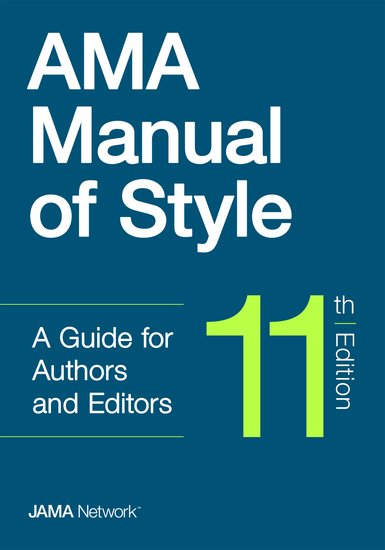
MODERATOR:
Stacy Christiansen
Managing Editor
JAMA
Chicago, Illinois
SPEAKERS:
Stacy Christiansen
Managing Editor
JAMA
Chicago, Illinois
Annette Flanagin
Executive Managing Editor and Vice President of Editorial Operations
JAMA Network
Chicago, Illinois
Cheryl Iverson
Managing Editor (retired)
JAMA Network
Chicago, Illinois
REPORTER:
Amanda Hand
University of Tennessee Institute of Agriculture
Knoxville, Tennessee
In 2019, the AMA Manual of Style will be unveiling its 11th edition. Therefore, three members from the AMA Manual of Style Committee highlighted recent updates and gave a sneak peek of the upcoming edition, including changes in references, formatting tables and figures, grammar, nomenclature, corrections and pervasive errors, authorship, data sharing statements, and updates to guidance about ethical review of research and informed consent.
For references, the publisher location will no longer be required due to many publishers having multiple locations. Additionally, the availability of books via online retailers make the physical location of publication unnecessary. Secondly, although DOIs and URLs will remain the last item in a citation, they will no longer be followed by a period in order to easily copy and paste the link. Finally, the references chapter in the new edition will include updated guidelines for social media references, preprints, apps, podcasts, databases, and other digital references.
While tables and figures were previously formatted to capitalize all major words in column and axis headings, tables and figures will now be formatted to sentence-style capitalization for all headings. Moreover, all table cells will be left aligned.
Recently, the Chicago Manual of Style and the AP Stylebook incorporated the use of “they” as a singular pronoun. The AMA Manual of Style will also accept “they” as a singular pronoun to alleviate the awkwardness of writing sentences in the plural and to help protect patient identities. Furthermore, grammar guidelines for posting on social media sites, especially Twitter, are introduced in the new manual, encompassing the need for proper capitalization, avoiding text jargon, and permitting the use of contractions and other recognized symbols, such as &, <, =, etc.
In regards to nomenclature, drugs included in manuscripts will no longer require the manufacturer’s location, and the use of aliases and nicknames for genes and proteins should be discouraged.
Because 21% of retractions are due to author error and not misconduct, the JAMA Network is hoping to minimize the stigma associated with retractions. Therefore, responses to editorial corrections and errors have been overhauled and basic protocols have been established. For minor errors in the text, the article ought to be corrected online, indicating the correction on both the HTML and PDF versions, and a correction notice is unnecessary. However, for more substantive errors, a correction notice is published, the article is corrected online for both the HTML and PDF versions, and the correction notice and corrected article are reciprocally linked. Finally, pervasive errors, inadvertent errors that require correcting important or numerous data throughout the text, may require either a retraction and replacement or simply a retraction. According to the new guidelines, a letter of explanation and a correction need to be published for articles with pervasive errors that do not affect the conclusions or interpretations, and have no statistically significant changes. However, a retraction and replacement is necessary for articles with valid science but with pervasive errors that change the direction, the significance of the results, and/or interpretations. The replacement article will retain the original DOI and any usage and citation metrics. Finally, a manuscript with pervasive errors that invalidate the science by changing the direction, the results, and/or the interpretations should be retracted.
Updates in authorship include new definitions for contributors, authors, group authors, and collaborators. Interestingly, co-first authors and co-corresponding authors are now accepted. However, co-corresponding authors must designate one author as the primary point of contact. Information on co-first authors can be displayed in the Acknowledgments section before the list of author contributions.
In 2018, the International Committee of Medical Journal Editors (ICMJE) began requiring the publication of a data sharing statement for clinical trials. A number of journals, research sponsors, and government agencies also have policies to encourage data sharing. Although a data sharing statement is optional for other study types, these statements are now required for clinical trials, but actual data sharing is not required.
Although initially released in 1991, the Regulations for the Protection of Human Subjects, or the “Common Rule,” was amended in 2017, with the revisions taking effect in January 2019. The AMA Manual of Style has modified its ethical review requirements to mirror the Common Rule changes. Under these changes, research involving human participants may be exempt from institutional review board (IRB) review based on the level of risk posed to the study participants. For example, low-risk research exempt from IRB review would be secondary research from an existing dataset that includes no identifiable participant information. Moreover, research with cadaver specimens is exempt because study participants must be living. Nevertheless, investigators should not determine for themselves if their study is exempt from IRB review; instead, they should follow national regulations or their institutional policies. If research includes study participants, authors should indicate in the Methods section that written or oral informed consent was obtained and indicate whether compensation or incentive was given to the study participants. If consent was waived or not needed, the authors should indicate why consent was not obtained using institutional policy or national regulations. Finally, the updated Common Rule allows a single IRB to review and approve studies conducted at multiple sites or centers in the United States, unless the study is conducted in other countries or governed by other US laws.
This is a brief synopsis of the changes set to be implemented later this year in the 11th edition of AMA Manual of Style. Until then, any style or policy updates are available at https://www.amamanualofstyle.com/page/updates and news and notes are provided on Twitter at @AMAManual.
